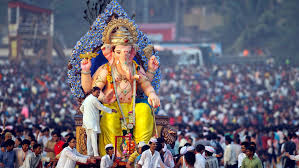Ganesh Chaturthi Vinayaka Chaturthi

Ganesh Chaturthi, also known as Vinayaka Chaturthi, is one of the most widely celebrated Hindu festivals in India. It is dedicated to Lord Ganesha, the elephant-headed deity, and is observed with great enthusiasm and devotion. This festival typically falls in the months of August or September, depending on the lunar calendar, and lasts for ten days, with the most elaborate celebrations taking place on the first day.
Here’s an overview of Ganesh Chaturthi, also referred to as Vinayaka Chaturthi:
1. Arrival of Lord Ganesha:
- On the first day of Ganesh Chaturthi, an idol of Lord Ganesha, usually made of clay, is brought home or to a communal pandal (temporary shrine).
- The idol is placed on a decorated platform or pedestal and is adorned with flowers, garlands, and various offerings.
2. Prayers and Rituals:
- Devotees offer prayers, sing devotional songs, and recite hymns in honor of Lord Ganesha.
- Various rituals and aarti (ceremonial prayers) are performed multiple times a day.
- Devotees seek blessings from Lord Ganesha for wisdom, success, and the removal of obstacles.
3. Modak Preparation:
- Modak, a sweet dumpling, is considered Lord Ganesha’s favorite food.
- Devotees prepare and offer modaks as a special prasad (offering) to the deity.
4. Cultural Programs:
- Ganesh Chaturthi is not only a religious festival but also a cultural extravaganza.
- Many places organize cultural programs, music, and dance performances during the ten-day festival.
5. Processions:
- On the final day, or the immersion day (Anant Chaturdashi), processions are organized to bid farewell to Lord Ganesha.
- The idol is carried in a grand procession through the streets, accompanied by music and dance.
- Devotees participate with great fervor and emotion.
6. Immersion (Visarjan):
- The highlight of Ganesh Chaturthi is the immersion of the idol in a water body, such as a river, lake, or sea.
- Devotees believe that Lord Ganesha returns to his heavenly abode on this day.
- The immersion signifies the cycle of creation and dissolution.
7. Environmental Concerns:
- In recent years, there has been a growing awareness of environmental concerns related to the immersion of idols made of non-biodegradable materials.
- Efforts are being made to encourage the use of eco-friendly idols and water bodies to minimize pollution.
8. Unity and Community Bonding:
- Ganesh Chaturthi transcends religious boundaries and brings people from diverse backgrounds together in a spirit of unity and community bonding.
- It is a time for social gatherings, feasting, and exchanging good wishes with friends and neighbors.
9. Symbolism:
- Lord Ganesha is revered as the god of wisdom, knowledge, and the remover of obstacles.
- His elephant head symbolizes wisdom, and his trunk signifies strength and adaptability.
- The mouse, his vehicle, represents his ability to conquer desires.
Ganesh Chaturthi, or Vinayaka Chaturthi, is not just a festival; it is an expression of devotion, culture, and the rich tapestry of Indian traditions. It serves as a reminder of the importance of seeking wisdom and the blessings of Lord Ganesha in one’s life, as well as fostering unity and community spirit among people of all backgrounds.
